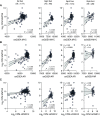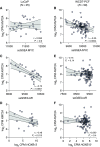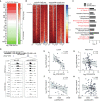Progression of prostate cancer reprograms MYC-mediated lipid metabolism via lysine methyltransferase 2A
- PMID: 36181613
- PMCID: PMC9526773
- DOI: 10.1007/s12672-022-00565-3
Progression of prostate cancer reprograms MYC-mediated lipid metabolism via lysine methyltransferase 2A
Abstract
Background: The activities of MYC, the androgen receptor, and its associated pioneer factors demonstrate substantial reprogramming between early and advanced prostate cancer. Although previous studies have shown a shift in cellular metabolic requirements associated with prostate cancer progression, the epigenetic regulation of these processes is incompletely described. Here, we have integrated chromatin immunoprecipitation sequencing (ChIP-seq) and whole-transcriptome sequencing to identify novel regulators of metabolism in advanced prostate tumors characterized by elevated MYC activity.
Results: Using ChIP-seq against MYC, HOXB13, and AR in LNCaP cells, we observed redistribution of co-bound sites suggestive of differential KMT2A activity as a function of MYC expression. In a cohort of 177 laser-capture microdissected foci of prostate tumors, KMT2A expression was positively correlated with MYC activity, AR activity, and HOXB13 expression, but decreased with tumor grade severity. However, KMT2A expression was negatively correlated with these factors in 25 LuCaP patient-derived xenograft models of advanced prostate cancer and 99 laser-capture microdissected foci of metastatic castration-resistant prostate cancer. Stratified by KMT2A expression, ChIP-seq against AR and HOXB13 in 15 LuCaP patient-derived xenografts showed an inverse association with sites involving genes implicated in lipid metabolism, including the arachidonic acid metabolic enzyme PLA2G4F. LuCaP patient-derived xenograft models grown as organoids recapitulated the inverse association between KMT2A expression and fluorine-18 labeled arachidonic acid uptake in vitro.
Conclusions: Our study demonstrates that the epigenetic activity of transcription factor oncogenes exhibits a shift during prostate cancer progression with distinctive phenotypic effects on metabolism. These epigenetically driven changes in lipid metabolism may serve as novel targets for the development of novel imaging agents and therapeutics.
Keywords: Lipid metabolism; Prostate cancer; Transcriptional regulation.
© 2022. The Author(s).
Conflict of interest statement
The authors declare no conflicts of interest.
Figures





References
-
- Barfeld SJ, Urbanucci A, Itkonen HM, Fazli L, Hicks JL, Thiede B, Rennie PS, Yegnasubramanian S, DeMarzo AM, Mills IG. c-Myc antagonises the transcriptional activity of the androgen receptor in prostate cancer affecting key gene networks. EBioMedicine. 2017;18:83–93. doi: 10.1016/j.ebiom.2017.04.006. - DOI - PMC - PubMed
Grants and funding
- Intramural Research Program, National Cancer Institute/NH/NIH HHS/United States
- Intramural Research Program, National Heart Lung and Blood Institute/NH/NIH HHS/United States
- Young Investigator Award/Prostate Cancer Foundation
- W81XWH-19-1-0712/Congressionally Directed Medical Research Programs
- W81XWH-16-1-0433/Congressionally Directed Medical Research Programs
LinkOut - more resources
Full Text Sources
Molecular Biology Databases
Research Materials
